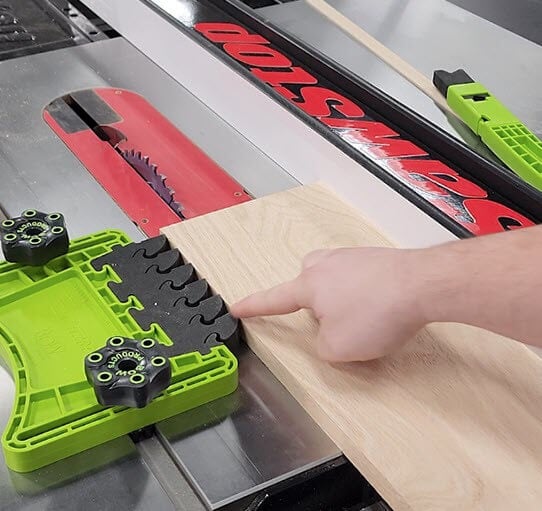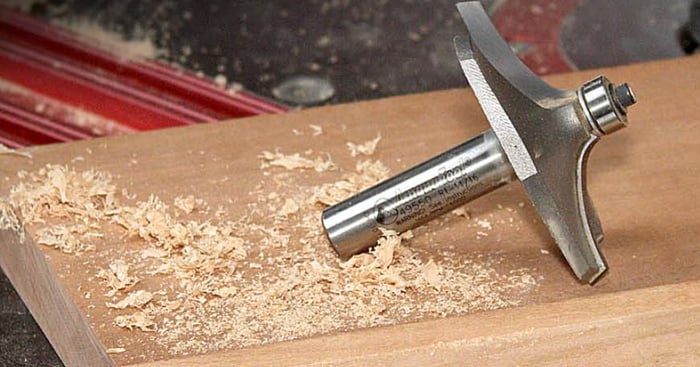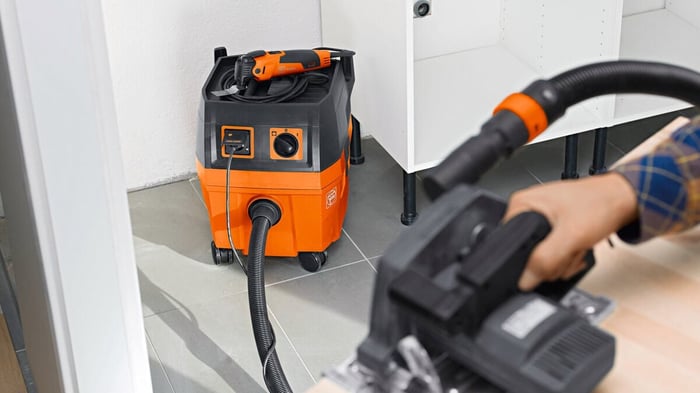
How to Avoid Kickback (Table Saw Safety)
We love SawStop table saws. Table saws are responsible for more than 30,000 emergency department visits each year, and 90% of those would be prevented with SawStop’s flesh-detecting technology.
But what about the other 10%? Enter Kickback.
Kickback injuries are caused by the workpiece being ejected toward the operator at high speed, usually as a result of the workpiece pinching the saw blade or being improperly fed through the saw.
While flesh-detection technology can dramatically reduce the severity of injuries from direct blade contact, it does not address the issue of kickback, which is a totally different type of hazard. (Although, if your hand is anywhere near the blade when kickback happens - you're in serious trouble.)
To prevent kickback injuries, other safety measures and devices are recommended, such as using a riving knife, featherboards and pushsticks, and maintaining proper alignment and support for the workpiece.

(A riving knife is that shark-fin-looking thing on the left. It sits behind the saw blade and is designed to prevent the workpiece from pinching the blade by keeping the cut sections of the workpiece separated. Virtually all table saws come with one. Please use yours.)
In summary, while flesh-detection technology is highly effective at reducing the risk of direct contact injuries, it does not specifically address kickback injuries. For kickback prevention, the use of appropriate safety devices and adherence to safe work practices are essential.
What is Kickback?
Kickback is a major hazard with table saws, occurring when the piece of wood being cut gets pinched between the saw blade and the rip fence. This causes the wood to be forcefully ejected back towards the operator at a high speed. It can happen very quickly and unexpectedly, posing a significant danger to the user.
- Injury from the wood piece: The ejected wood can strike the operator with considerable force, leading to cuts, bruises, or more severe injuries.
- Hand or body contact with the blade: The sudden movement of the wood can cause the operator's hand or body to move towards the saw blade, potentially resulting in lacerations, amputations, or other serious injuries. (Not everyone has a SawStop, and even if you do, you might have the tech off because you’re cutting metal or other conductive material.)
- Loss of control: The surprise and force of the kickback can cause the operator to lose control of the saw or the workpiece, increasing the risk of accidents.
- Damage to the workshop: The ejected piece can also damage other equipment or items in the workshop as it is propelled at high speed.
- Psychological impact: Experiencing or witnessing a kickback can lead to fear of using the table saw, affecting the operator's confidence and possibly leading to hesitation or errors in future work.

Set-Up
Ensuring the table saw blade, fence, and miter slot are properly aligned and maintained is crucial for safe operation.
- Align the Blade with the Miter Slot. Ensure the table saw blade is perfectly aligned with the miter slot using a combination square to check the gap is even across its length.
- Align the fence to be parallel to the miter slots and blade for accurate cuts. Consult your saw's manual for adjustment instructions.
- Verify the blade is set to a true 90° angle for square cuts, regardless of what the indicator says.
- Adjust blade height so that the teeth are just above the top of the material being cut to reduce risk of injury.
- Install the riving knife provided with your saw to prevent kickback, and blade guards to protect your hands.
- Regular maintenance, such as aligning the fence, cleaning the table, and ensuring the blade is properly installed and aligned, is crucial for safe and accurate cuts.

Prepare Your Materials
- Use Sharp Table Saw Blades: A sharp blade is essential for smooth cuts and reduces the likelihood of kickback. Dull blades require more force to cut and can burn the wood, while the wrong blade type can lead to poor cuts and increased danger. Use sharp blades and choose the correct blade for the material and type of cut.
- Ensure wood is flat and not twisted or bowed to prevent kickback. Avoid twisted, warped, or cupped boards. Improperly prepared wood can move unpredictably, leading to potential accidents.
- Check for metal objects in the wood. Nails, screws, or other metal objects in the wood can cause the blade to catch or kick back. Always inspect the wood before cutting.
Ensure Proper Handling
- Never EVER make freehand cuts; always use the fence and ensure the material is flat against the table and fence when starting a cut. Freehand cutting can lead to inaccurate cuts, loss of control and blade binding. Always use the fence or miter gauge for support.
- Secure the workpiece: If the workpiece is not firmly against the fence or table, it can move during the cut, leading to inaccuracies or kickback. Ensure the workpiece is securely positioned before cutting.
- Never use the fence as a stop block for crosscuts. Instead, use a crosscut sled (building your own is a good beginner’s project), or use a circular saw or miter saw.
- In fact, don’t rip boards that are wider than they are long: This practice is unstable and can lead to difficulty in keeping the board against the fence, increasing the risk of kickback. Another good use for a sled.
- Stand to the left of the blade. Stand slightly to the side when feeding boards through the saw to avoid being in the path of potential kickback. Standing directly behind the blade or reaching over it can be dangerous, especially in the event of kickback. Stand to one side, and keep a stable, balanced stance.
- Use push sticks correctly: Start pushing the material with your hands behind it and switch to a push stick as you proceed, placing it near the center or closer to the left of the material, which pushes the wood against the fence, for better control.
- Don’t twist the board. Twisting increases friction and can cause the blade to bind and kick back dangerously. Also, if you apply too much force towards the fence with your outside hand, that can cause the blade to bind by “squeezing the cut.”
- No “Levering!” Avoid letting the front of the board lift off the table saw at the start of a cut. As it lowers onto the saw blade, it can lead to sudden friction and kickback.
- Do not start a cut in the middle of the board (drop cutting) with a table saw, as it's highly risky and can lead to board ejection and injury. Another good use for a circular saw, or a jigsaw.
- Support the workpiece properly on both the infeed and outfeed sides to prevent it from binding or kicking back. On long boards, ensure the outfeed (the part of the board exiting the saw) is supported to prevent the board from tipping and causing dangerous movements.

Safety Tools
- Featherboards: Help prevent kickback by locking into place if something binds and starts to kick back, while also keeping the stock against the fence for more accurate cuts. Important to set up before the blade to avoid pinching and causing kickback.
- Push Sticks and Push Blocks: Essential for safety, these tools keep your hands away from the blade. Commercial options like the Bow push sticks and the Micro Jig Gripper are recommended for their effectiveness. The Gripper, in particular, is praised for its versatility and safety features. Homemade push sticks are also a viable option, with free plans available online.
- Miter Gauge: A good miter gauge, like the Incra V27, is suggested for those intimidated by building a crosscut sled. It offers accuracy for cross cuts and is a significant improvement over the typically subpar gauges that come with saws.
- Personal Protective Equipment (PPE): Safety glasses, hearing protection, and dust masks (like the RZ Mask) are essential for personal safety. Skipping safety glasses & ear protection, or wearing appropriate clothing, can all lead to serious injuries. Always wear protective equipment.
 Festool noise reducing earphones.
Festool noise reducing earphones.
OSHA-compliant, ANSI-rated 25 Db noise reduction, wireless Bluetooth® 5.2, allows you to work comfortably for up to 13 hours while also listening to music, holding conversations, and making phone calls. What an amazing world we live in.





